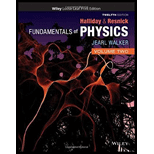
ILW In Fig. 9-21, projectile particle 1 is an alpha particle and target particle 2 is an oxygen nucleus. The alpha particle is scattered at angle θ1 = 64.0° and the oxygen nucleus recoils with speed 1.20 × 105 m/s and at angle θ2 = 51.5°. In

Figure 9-21 An elastic collision between two bodies in which the collision is not head-on. The body with mass m2 (the target) is initially at rest.
Want to see the full answer?
Check out a sample textbook solution
Chapter 9 Solutions
FUND.OF PHYSICS (LL)-PRINT COMP.VOL.2
Additional Science Textbook Solutions
Cosmic Perspective Fundamentals
Biology: Life on Earth (11th Edition)
Laboratory Experiments in Microbiology (12th Edition) (What's New in Microbiology)
Campbell Biology (11th Edition)
Biology: Life on Earth with Physiology (11th Edition)
Physics for Scientists and Engineers: A Strategic Approach, Vol. 1 (Chs 1-21) (4th Edition)
- In the following figure the circuit to the left has a switch thatat t = 0 s is switched and disconnects the battery from the circuit. The state depicted on thefigure is right after the switch, still t = 0. As the current decreases over time, the magneticflux through the circuit on the right (due to the long cable of the circuit on the left) changesand induces an EMF on the right circuit. How much power is consumed by R2 as a functionof time.The distance between the wire on the left and the closest wire on the right is r = 2.0 cm.The size of the circuit on the right is noted on the figure.arrow_forwardsingly A samply ionized helium atom is in the ground state. It absorbs energy and makes a transition to the n=7 excited state. The ion returns to wo the wavelength the ground state by emitting SIX photons ONLY. What is the of the second highest energy photon ?arrow_forwardAn electron, traveling at a speed of 5.60x10° m/s, strikes the target of an X-ray tube. Upon impart, the eletion decelerates to one-third of it's original speed, with an X-ray photon being emitted in the process. What is the wavelength of the photon? m.arrow_forward
- Can you help me solve this 2 question and teach me what we use to solve thisarrow_forwardYou are working during the summer at a company that builds theme parks. The company is designing an electromagnetic propulsion system for a new roller coaster. A model of a substructure of the device appears in the figure below. Two parallel, horizontal rails extend from left to right, with one rail behind the other. A cylindrical rod rests on top of and perpendicular to the rails at their left ends. The distance between the rails is d and the length of the rails is L. The magnetic field vector B points vertically down, perpendicular to the rails. Within the rod, the current I flows out of the page, from the rail in the back toward the rail in the front. The rod is of length d = 1.00 m and mass m = 0.700 kg. The rod carries a current I = 100 A in the direction shown and rolls along the rails of length L = 20.0 m without slipping. The entire system of rod and rails is immersed in a uniform downward-directed magnetic field with magnitude B = 2.30 T. The electromagnetic force on the rod…arrow_forwardBased on the graph, explain how centripetal force is affected when the hanging mass changes. Does your graph verify the relationship in the equation r = x^i + y^j = r cos ωt I + r sin ωt^j?arrow_forward
- Can you help me to solve this two questions can you teach me step by step how to solve it.arrow_forwardGiven: ruler 11.56 g, small washer 1.85 g each, large washer 24.30g each Use the data in Data Tables 4 and 5 to experimentally determine the mass of your ruler. Use one of your 2 trials with 1 small washer at 0 cm, one of your 2 trials with 2 small washers at 0 cm, and one of your 2 trials with 3 small washers at 0 cm to find three experimental values for the mass of the ruler. How do you experimentalls determine the mass?arrow_forwardCompare the 3 experimental masses of your ruler to the measured mass of your ruler (Data Table 1) by calculating the percent error for each experimental value. Which trial provided the best data for determining the mass of the ruler? Please help, I am not sure how to calculate this. Thanks!arrow_forward
- Please help, everytime I try to input the data only one point shows on the graph. Please graph unsing centripetal force, Fc, versus V E2 from Activity 1. Include a line of best fit and record the equation of the line. Thank you!arrow_forwardPlease help, everytime I try to input the data only one point shows on the graph. Graph of centripetal force, Fc, versus V E2 from Activity 1. Include a line of best fit and record the equation of the line.arrow_forwardBased on your graph, explain how centripetal force is affected when the hanging mass changes. Does your graph verify the relationship in the equation r = x^i + y^j = r cos ωt I + r sin ωt^j?arrow_forward
 Principles of Physics: A Calculus-Based TextPhysicsISBN:9781133104261Author:Raymond A. Serway, John W. JewettPublisher:Cengage Learning
Principles of Physics: A Calculus-Based TextPhysicsISBN:9781133104261Author:Raymond A. Serway, John W. JewettPublisher:Cengage Learning Classical Dynamics of Particles and SystemsPhysicsISBN:9780534408961Author:Stephen T. Thornton, Jerry B. MarionPublisher:Cengage Learning
Classical Dynamics of Particles and SystemsPhysicsISBN:9780534408961Author:Stephen T. Thornton, Jerry B. MarionPublisher:Cengage Learning Physics for Scientists and Engineers: Foundations...PhysicsISBN:9781133939146Author:Katz, Debora M.Publisher:Cengage Learning
Physics for Scientists and Engineers: Foundations...PhysicsISBN:9781133939146Author:Katz, Debora M.Publisher:Cengage Learning College PhysicsPhysicsISBN:9781305952300Author:Raymond A. Serway, Chris VuillePublisher:Cengage Learning
College PhysicsPhysicsISBN:9781305952300Author:Raymond A. Serway, Chris VuillePublisher:Cengage Learning Physics for Scientists and Engineers with Modern ...PhysicsISBN:9781337553292Author:Raymond A. Serway, John W. JewettPublisher:Cengage Learning
Physics for Scientists and Engineers with Modern ...PhysicsISBN:9781337553292Author:Raymond A. Serway, John W. JewettPublisher:Cengage Learning Modern PhysicsPhysicsISBN:9781111794378Author:Raymond A. Serway, Clement J. Moses, Curt A. MoyerPublisher:Cengage Learning
Modern PhysicsPhysicsISBN:9781111794378Author:Raymond A. Serway, Clement J. Moses, Curt A. MoyerPublisher:Cengage Learning





